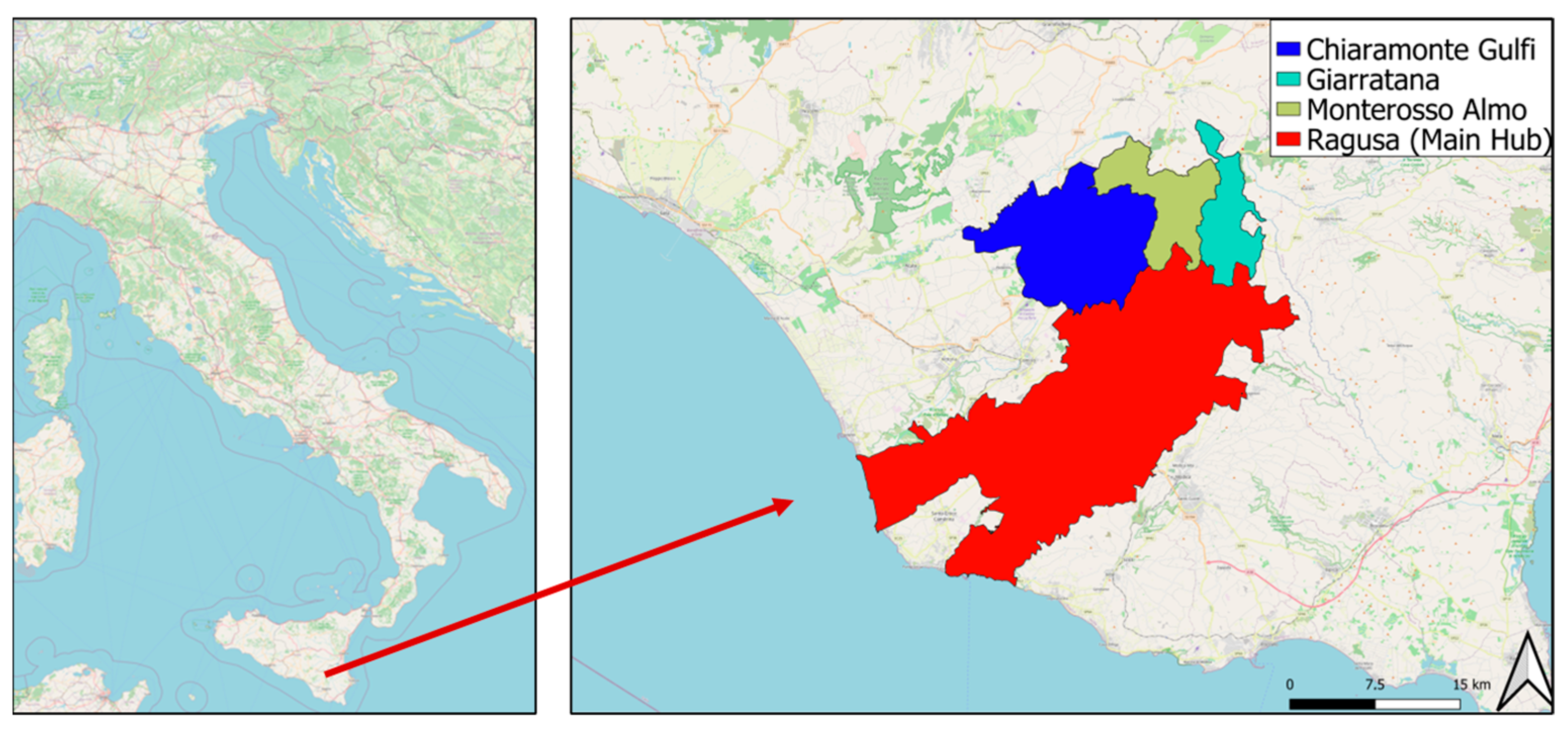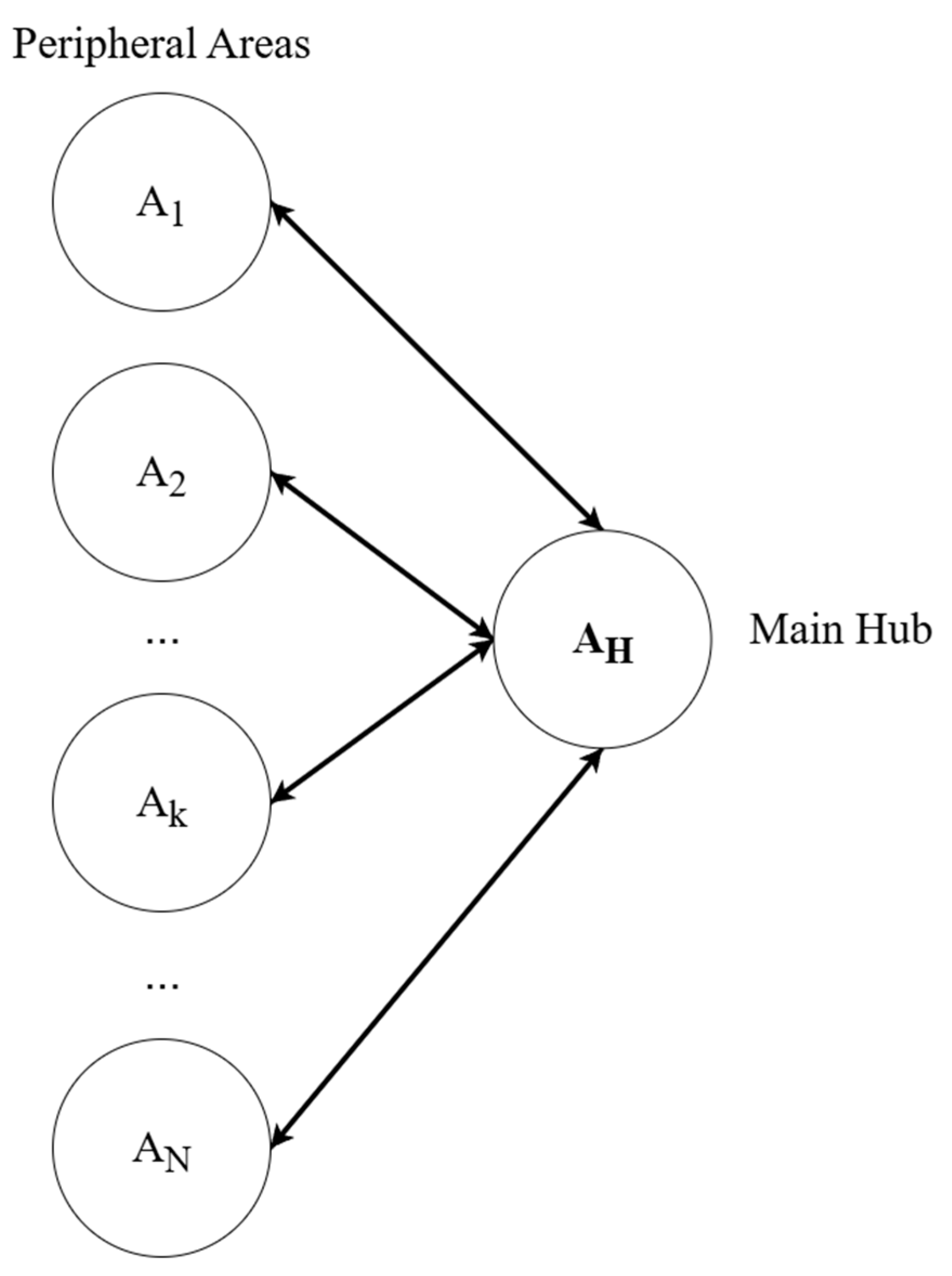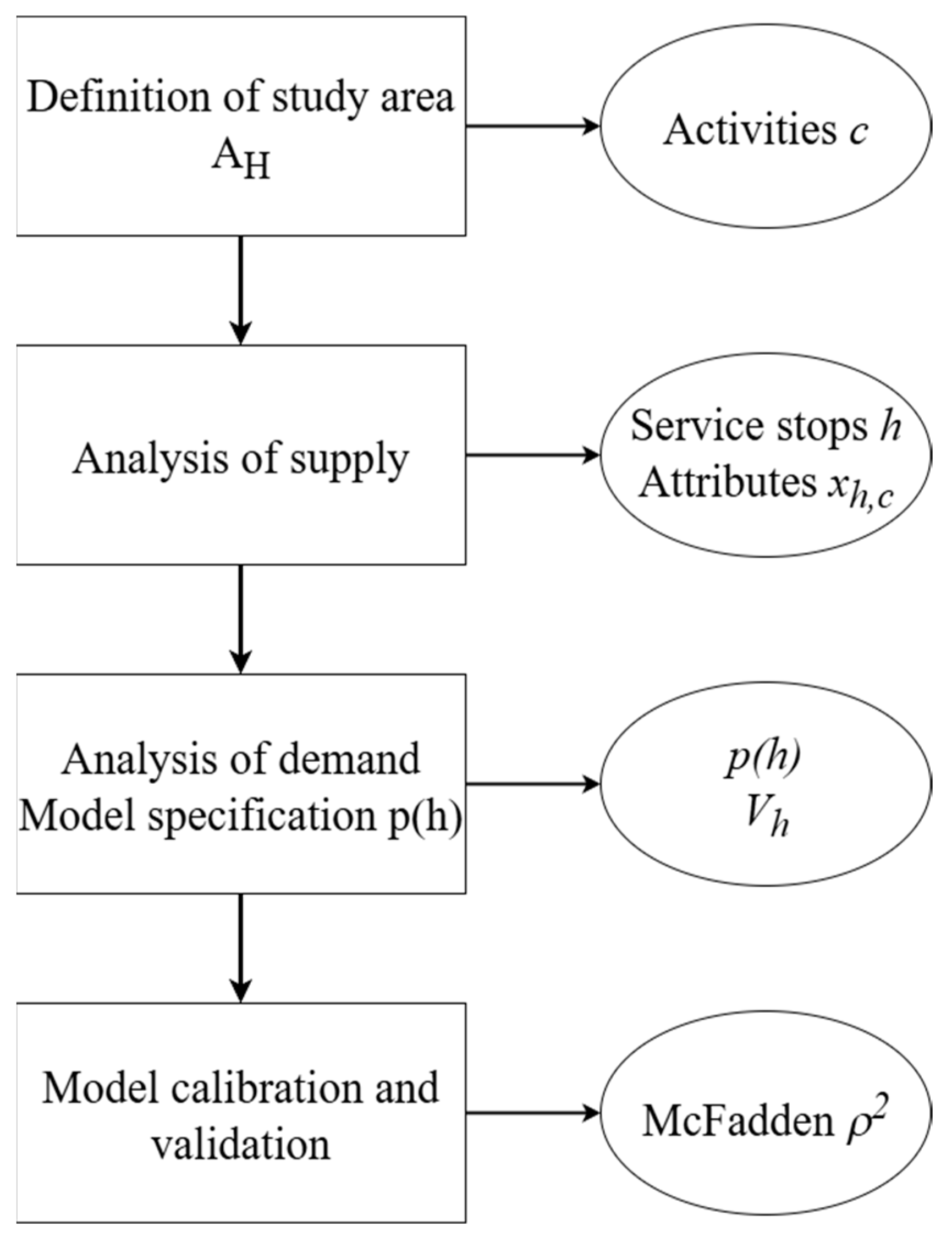A Logit Approach to Study the Attractiveness of DRT Stops Location: The Case Study of Ragusa, Italy
Abstract
1. Introduction
2. Background
2.1. Factors Affecting DRT
2.2. Modelling Approaches for DRTs
3. Materials and Methods
3.1. Case Study Description
3.2. Data Acquisition
3.3. Modelling
- The evaluation was carried out considering the five groups of activities:
- Instruction,
- Healthcare,
- Modal interchange,
- Sports,
- Shopping,
- The specification of the systematic utility is reported in Equation (7).
4. Results
5. Discussion
- The first is directly related to the service’s operating hours, which are in the afternoon. It is possible that most of these healthcare facilities operate in the morning for non-emergency cases.
- The second is related to some users’ details; this element could indicate greater reluctance on the part of users to use the service for personal reasons such as health. This element deserves the attention of the operator and future research, focused on user characteristics and tendencies.
6. Conclusions and Future Development
Author Contributions
Funding
Institutional Review Board Statement
Informed Consent Statement
Data Availability Statement
Acknowledgments
Conflicts of Interest
References
- Statistics, U.N. Global indicator framework for the sustainable development goals and targets of the 2030 agenda for sustainable development. In Developmental Science and Sustainable Development Goals for Children and Youth; SDG: New York, NY, USA, 2019; p. 439. [Google Scholar]
- Zhang, C.; Wang, M.; Dong, J.; Lu, W.; Liu, Y.; Ni, A.; Yu, X. Factors and mechanism affecting the attractiveness of public transport: Macroscopic and microscopic perspectives. J. Adv. Transp. 2022, 2022, 5048678. [Google Scholar] [CrossRef]
- Göransson, J.; Andersson, H. Factors that make public transport systems attractive: A review of travel preferences and travel mode choices. Eur. Transp. Res. Rev. 2023, 15, 32. [Google Scholar] [CrossRef]
- Cruz, I.S.; Katz-Gerro, T. Urban public transport companies and strategies to promote sustainable consumption practices. J. Clean. Prod. 2016, 123, 28–33. [Google Scholar] [CrossRef]
- Silva, C.; Cadima, C.; Castro, N.; Tennøy, A. Public transport strategy. J. Transp. Land Use 2021, 14, 1275–1294. [Google Scholar] [CrossRef]
- Nourbakhsh, S.M.; Ouyang, Y. A structured flexible transit system for low demand areas. Transp. Res. Part B Methodol. 2012, 46, 204–216. [Google Scholar] [CrossRef]
- Yan, X.; Zhao, X.; Han, Y.; Van Hentenryck, P.; Dillahunt, T. Mobility-on-demand versus fixed-route transit systems: An evaluation of traveler preferences in low-income communities. Transp. Res. Part A Policy Pract. 2021, 148, 481–495. [Google Scholar] [CrossRef]
- Brake, J.; Nelson, J.D.; Wright, S. Demand responsive transport: Towards the emergence of a new market segment. J. Transp. Geogr. 2004, 12, 323–337. [Google Scholar] [CrossRef]
- Davison, L.; Enoch, M.; Ryley, T.; Quddus, M.; Wang, C. Identifying potential market niches for Demand Responsive Transport. Res. Transp. Bus. Manag. 2012, 3, 50–61. [Google Scholar] [CrossRef]
- Brost, M.; Klötzke, M.; Kopp, G.; Deißer, O.; Fraedrich, E.M.; Karnahl, K.; Sippel, T.; Müller, A.; Beyer, S. Development, implementation (pilot) and evaluation of a demand-responsive transport system. World Electr. Veh. J. 2018, 9, 4. [Google Scholar] [CrossRef]
- Campisi, T.; Spadaro, C.; Russo, A.; Tesoriere, G.; Torrao, G. The Development of Integrated Public Transport and on Demand Services (PTs-DRTs) for Greater Flexibility and Complementarity of Transport Mode Choices. In International Conference on Computational Science and Its Applications; Springer Nature: Cham, Switzerland, 2025; pp. 48–64. [Google Scholar]
- Musolino, G. Sustainable Mobility as a Service: Demand analysis and case studies. Information 2022, 13, 376. [Google Scholar] [CrossRef]
- Campisi, T.; Canale, A.; Ticali, D.; Tesoriere, G. Innovative solutions for sustainable mobility in areas of weak demand. Some factors influencing the implementation of the DRT system in Enna (Italy). In AIP Conference Proceedings; AIP Publishing LLC: Melville, NY, USA, 2021; Volume 2343, p. 090005. [Google Scholar]
- Cascetta, E. Transportation Systems Engineering: Theory and Methods; Springer Science & Business Media: Berlin/Heidelberg, Germany, 2013; Volume 49. [Google Scholar]
- Pratelli, A. Ingegneria Dei Sistemi Di Trasporto; Pitagora: Roma, Italy, 1998. [Google Scholar]
- Ryley, T.J.; Stanley, P.A.; Enoch, M.P.; Zanni, A.M.; Quddus, M.A. Investigating the contribution of Demand Responsive Transport to a sustainable local public transport system. Res. Transp. Econ. 2014, 48, 364–372. [Google Scholar] [CrossRef]
- Charisis, A.; Iliopoulou, C.; Kepaptsoglou, K. DRT route design for the first/last mile problem: Model and application to Athens, Greece. Public Transp. 2018, 10, 499–527. [Google Scholar] [CrossRef]
- Jevinger, Å.; Svensson, H. On Demand-Responsive Transport Configurations, Traveller Interaction and Preferences: A Survey from the Perspective of Older People; Public Transport: Singapore, 2025; pp. 1–40. [Google Scholar]
- Cartenì, A.; Henke, I.; Picone, M. The value of waiting spaces: Tourists’ willingness to pay for high-quality bus terminals. Transp. Res. Interdiscip. Perspect. 2024, 26, 101129. [Google Scholar] [CrossRef]
- Tamleh, D.; Schlenther, T.; Nagel, K. Investigating the impact of stop network designs on drt operation. Procedia Comput. Sci. 2024, 238, 742–748. [Google Scholar] [CrossRef]
- Mahfouz, H.; Morgan, M.; Heinen, E.; Lovelace, R. Delineating potential DRT operating areas: An origin–destination clustering approach. J. Urban Mobil. 2025, 8, 100135. [Google Scholar] [CrossRef]
- Kato, H.; Yoh, K. Acceptance and use of demand-responsive transport by older people in old new town: Evidence from Senboku new Town. Transp. Res. Interdiscip. Perspect. 2025, 29, 101295. [Google Scholar]
- Hu, S.; Li, C.; Wu, W.; Yang, Y. Exploring the determinants of demand-responsive transit acceptance in China. Transp. Policy 2025, 165, 150–163. [Google Scholar] [CrossRef]
- Avermann, N.; Schlüter, J. Determinants of customer satisfaction with a true door-to-door DRT service in rural Germany. Res. Transp. Bus. Manag. 2019, 32, 100420. [Google Scholar] [CrossRef]
- Russo, A.; Campisi, T.; Tesoriere, G.; Spadaro, C.; Torrao, G. DRT and Social Exclusion: A Literature Review on Gender, Age and Income Impact. In International Conference on Computational Science and Its Applications; Springer: Cham, Switzerland, 2026; pp. 157–174. [Google Scholar]
- Guo, J.; Mishra, S.; Brakewood, C. Analyzing gender and age differences in travel patterns and accessibility for demand response transit in small urban areas: A case study of Tennessee. J. Transp. Land Use 2024, 17, 675–706. [Google Scholar] [CrossRef]
- Gkavra, R.; Susilo, Y.O.; Klementschitz, R. Determinants of usage and satisfaction with demand responsive transport systems in rural areas. Transp. Res. Rec. 2024, 2678, 667–680. [Google Scholar]
- Kirsimaa, K.; Suik, K. Demand-Responsive Transport (Drt) in the Baltic Sea Region and Beyond; ClimaResponse: Stockholm, Sweden, 2020. [Google Scholar]
- Available online: http://acco.gencat.cat/ (accessed on 1 September 2025).
- Schasché, S.E.; Wankmüller, C.; Hampl, N. Understanding the behavioral intention of the rural population to use demand-responsive transport services. Transp. Res. Interdiscip. Perspect. 2023, 22, 100984. [Google Scholar] [CrossRef]
- Pavanini, T.; Liimatainen, H.; Sievers, N.; Heemsoth, J.P. The role of DRT in European urban public transport systems—A comparison between Tampere, Braunschweig and Genoa. Future Transp. 2023, 3, 584–600. [Google Scholar]
- Goto, Y.; Sanko, N. Quantifying the economic value of reservation deadlines in demand-responsive transport. Transp. Plan. Technol. 2024, 48, 1442–1453. [Google Scholar] [CrossRef]
- Caramuta, C.; Grosso, A.; Longo, G.; Ricchetti, C.; Rotaris, L. Design, implementation and monitoring of a Demand Responsive Transport service for student leisure transfers: The case study of University of Trieste. Transp. Eng. 2025, 20, 100345. [Google Scholar] [CrossRef]
- Gilibert, M.; Ribas, I.; Rosen, C.; Siebeneich, A. On-demand shared ride-hailing for commuting purposes: Comparison of Barcelona and Hanover case studies. Transp. Res. Procedia 2020, 47, 323–330. [Google Scholar]
- Parmaksizoglou, I.A.; Bombelli, A.; Sharpanskykh, A. Design of a Demand Responsive Transport service using Distributed Constraint Optimization for airport access. In Proceedings of the 2023 8th International Conference on Models and Technologies for Intelligent Transportation Systems (MT-ITS), Nice, France, 14–16 June 2023; IEEE: New York, NY, USA, 2023; pp. 1–6. [Google Scholar]
- Fan, Y.; Wu, Z.; Liu, S. Examining the Factors Influencing the Choice of Rail Transit Connection Mode Considering Demand-Responsive Transport. In ICRT 2024; ASCE: Reston, VA, USA, 2024; pp. 554–562. [Google Scholar]
- Attard, M.; Camilleri, M.P.; Muscat, A. The technology behind a shared demand responsive transport system for a university campus. Res. Transp. Bus. Manag. 2020, 36, 100463. [Google Scholar] [CrossRef]
- McFadden, D. Conditional Logit Analysis of Qualitative Choice Behavior; Academic Press: New York, NY, USA, 1972. [Google Scholar]
- Ben-Akiva, M.E.; Lerman, S.R. Discrete Choice Analysis: Theory and Application to Travel Demand; MIT Press: Cambridge, MA, USA, 1985; Volume 9. [Google Scholar]
- Wong, R.C.P.; Yang, L.; Szeto, W.Y. Comparing passengers’ satisfaction with fixed-route and demand-responsive 634 transport services: Empirical evidence from public light bus services in Hong Kong. Travel Behav. Soc. 2023, 32, 100583. [Google Scholar]
- Terry, J.; Bachmann, C. Estimating suburban preferences for integrated public transit and ridesourcing services through a revealed-preference/stated-preference survey. J. Public Transp. 2023, 25, 100047. [Google Scholar] [CrossRef]
- Park, J.; Choi, S.; Kim, G.; Jo, H. Provision of metropolitan demand responsive transit and attitude’s role in modechoice. Transp. Res. Part D Transp. Environ. 2025, 140, 104640. [Google Scholar] [CrossRef]
- Lao, X.; Shen, Y.; Cao, J.; Ji, Y.; Du, Y. Does implicit attitude affect travel mode choice behaviors? A study of customized bus attraction to urban railway riders. Transp. Lett. 2025, 17, 1399–1413. [Google Scholar] [CrossRef]
- Tordai, D.; Lieszkovszky, J.P.; Munkácsy, A. Preferences of Rural Travelers Towards Demand Responsive Transport. In Transport Research Arena Conference; Springer Nature: Cham, Switzerland, 2024; pp. 66–71. [Google Scholar]
- He, J.; Ma, T.Y. Examining the factors influencing microtransit users’ next ride decisions using Bayesian networks. Eur. Transp. Res. Rev. 2022, 14, 47. [Google Scholar] [CrossRef]
- Wang, C.; Quddus, M.; Enoch, M.; Ryley, T.; Davison, L. Exploring the propensity to travel by demand responsive transport in the rural area of Lincolnshire in England. Case Stud. Transp. Policy 2015, 3, 129–136. [Google Scholar] [CrossRef]
- Istat. Basi Territoriali e Variabili Censuarie (Istat.It); Istat: Rome, Italy, 2025. [Google Scholar]
- OpenStreetMap. About OpenStreetMap. 2025. Available online: https://wiki.openstreetmap.org/wiki/About_OpenStreetMap (accessed on 1 September 2025).
- Erlander, S.; Stewart, N.F. The Gravity Model in Transportation Analysis: Theory and Extensions; Vsp: Rancho Cordova, CA, USA, 1990; Volume 3. [Google Scholar]
- Croissant, Y. Estimation of random utility models in R: The mlogit package. J. Stat. Softw. 2020, 95, 1–41. [Google Scholar] [CrossRef]
- R Core Team. R: A Language and Environment for Statistical Computing; R Foundation for Statistical Computing: Vienna, Austria, 2025; p. 650. Available online: https://www.R-project.org/ (accessed on 1 September 2025).
- Savant, S.; Sharma, N.; Baghel, A.S. Demand Responsive Public Transport System in Airport Travel: Case Study of Delhi. In Conference on Sustainable Urban Mobility; Springer International Publishing: Cham, Switzerland, 2020; pp. 42–55. [Google Scholar]
- Mageean, J.; Nelson, J.D. The evaluation of demand responsive transport services in Europe. J. Transp. Geogr. 2003, 11, 255–270. [Google Scholar] [CrossRef]
- Davison, L.; Enoch, M.; Ryley, T.; Quddus, M.; Wang, C. A survey of demand responsive transport in Great Britain. Transp. Policy 2014, 31, 47–54. [Google Scholar] [CrossRef]





| Market | References |
|---|---|
| Rural | [30,31] |
| Sanitary | [16,32] |
| Shopping and leisure | [33,34] |
| Modal interchange | [35,36] |
| Work/Instruction | [34,37] |
| Datum Name | Explanation |
|---|---|
| Booking ID | This data represents the booking ID. Some bookings were made but then cancelled. The corresponding IDs have been removed from the study. |
| Pick-up Time | This represents the exact time at which the pick-up took place at the location indicated by the user. |
| Pick-up Point | This represents the point where the pick-up took place, as indicated by the user, from among the set of possible points offered by the company. |
| Drop-off Time | This represents the exact time when the drop-off took place at the point indicated by the user. |
| Drop-off Point | This represents the point where the drop-off took place, from among the set of possible points offered by the company. |
| Attribute | |||||
|---|---|---|---|---|---|
| 1 | |||||
| −0.32 | 1 | ||||
| −0.33 | −0.25 | 1 | |||
| −0.16 | −0.24 | 0.09 | 1 | ||
| 0.05 | 0.15 | −0.14 | 0.09 | 1 |
| Name | Attribute | Parameter | Estimate | z-Value | McFadden ρ2 |
|---|---|---|---|---|---|
| Instruction | 2.11 | 4.72 * | 0.28 | ||
| Healthcare | −0.51 | −0.879 | |||
| Modal | 2.24 | 4.71 * | |||
| Sport | 2.55 | 7.49 * | |||
| Shopping | 1.56 | 3.64 * |
Disclaimer/Publisher’s Note: The statements, opinions and data contained in all publications are solely those of the individual author(s) and contributor(s) and not of MDPI and/or the editor(s). MDPI and/or the editor(s) disclaim responsibility for any injury to people or property resulting from any ideas, methods, instructions or products referred to in the content. |
© 2025 by the authors. Licensee MDPI, Basel, Switzerland. This article is an open access article distributed under the terms and conditions of the Creative Commons Attribution (CC BY) license (https://creativecommons.org/licenses/by/4.0/).
Share and Cite
Russo, A.; Campisi, T.; Spadaro, C.; Torrao, G.; Tesoriere, G. A Logit Approach to Study the Attractiveness of DRT Stops Location: The Case Study of Ragusa, Italy. Future Transp. 2025, 5, 156. https://doi.org/10.3390/futuretransp5040156
Russo A, Campisi T, Spadaro C, Torrao G, Tesoriere G. A Logit Approach to Study the Attractiveness of DRT Stops Location: The Case Study of Ragusa, Italy. Future Transportation. 2025; 5(4):156. https://doi.org/10.3390/futuretransp5040156
Chicago/Turabian StyleRusso, Antonio, Tiziana Campisi, Chiara Spadaro, Guilhermina Torrao, and Giovanni Tesoriere. 2025. "A Logit Approach to Study the Attractiveness of DRT Stops Location: The Case Study of Ragusa, Italy" Future Transportation 5, no. 4: 156. https://doi.org/10.3390/futuretransp5040156
APA StyleRusso, A., Campisi, T., Spadaro, C., Torrao, G., & Tesoriere, G. (2025). A Logit Approach to Study the Attractiveness of DRT Stops Location: The Case Study of Ragusa, Italy. Future Transportation, 5(4), 156. https://doi.org/10.3390/futuretransp5040156









